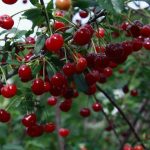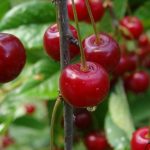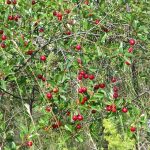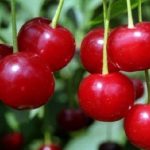Cherry steppe is a hybrid that was obtained as a result of the crossing of shrub and garden cherries. If you decide to plant this particular type of berry on the plot, first you should get acquainted with the description, namely understand the characteristics of this variety, in what conditions it grows best, what soil is most favorable for it. In addition, it is worth remembering a few important features of the care of this plant, but still about everything in order. First of all, it is worth finding out what kind of species it is and what qualities it possesses.
Table of contents
Description of steppe bush cherry
Breeding history
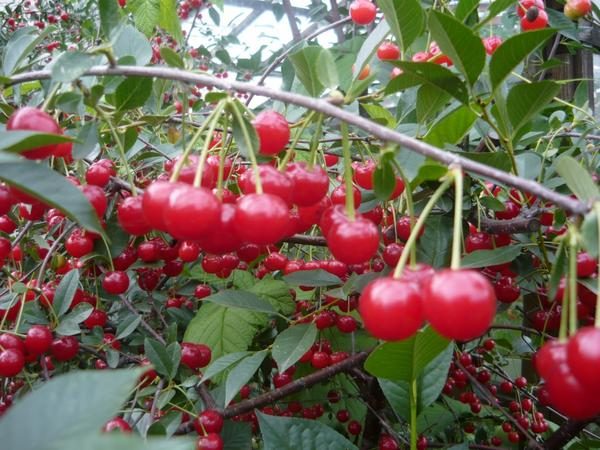
The composition of the state international registry this species was introduced in early 2002. This type of cherry belongs to successful hybrids between cherries and ordinary cherries.
The authors-scientists who worked on the breeding of this species are Anastasia Efimovna Pankratova, Kabir Kadirovich Mullayanov, Vladimir Ilyich Putiagin, IG Zamyatin
Regions of growth
This bush type of cherry is widely distributed in all regions of Russia and CIS countries. Steppe cherry grows in areas:
- In the Ural region;
- In the Caucasus;
- In the Kuban;
- In the Volga region;
- In the Nizhny Novgorod region;
- In the Rostov region;
- In the Voronezh region;
- In the Yaroslavl region.
Appearance Description
Characteristics of the tree
Steppe cherry trees have the following characteristics:
- Varieties of this type have slender trees, no crowns connection;
- Tree height ranges from 2.6 to 3.2 meters;
- Thumb size equal to about 20-45 centimeters;
- Crohn strong and dense. The shape of the crown cylindrical and elongated type;
- On crowns available a large number of leaves;
- Shoots have oval, slightly rounded shapes, they may have a small amount of fluffs;
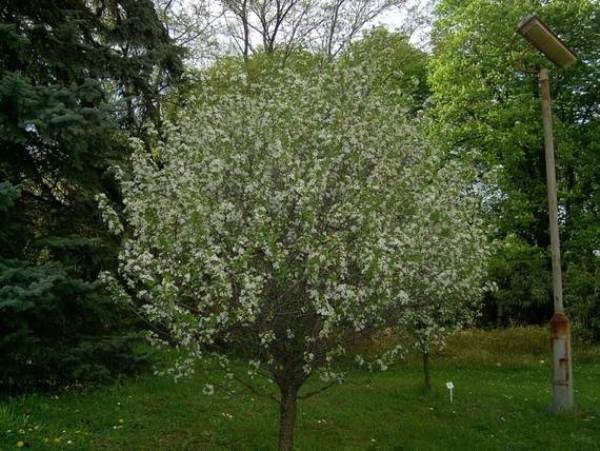
- Coloring shoots brown-gray with silver color;
- The length of the shoots can reach up to 30-45 cm;
- Chechevichki have medium size, settle down in a small amount;
- Kidney is bent, quite long, has medium size. The touch is smooth, smooth;
- Foliage the trees have a dark saturated green tint;
- Leaf shape rounded, slightly narrowed, oblong, has a slight bend upwards;
- The size The length can be up to 8 cm on average, and the width to 4 cm.
Fruit quality
Steppe cherry berry has a number of characteristics:
- Berry Shape oval with slightly rounded edges;
- A lot of ripe fruits ranges from 4.2 grams to 5 grams;
- Coloring ripe fruit maroon, inside the structure of the pulp has a burgundy shade with the juice of bright red flowers;
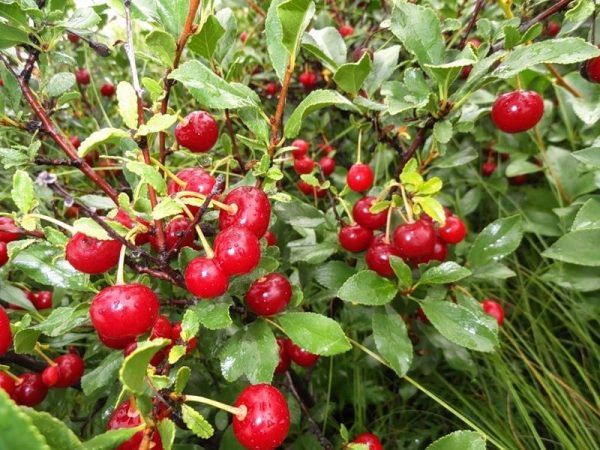
- Skin of cherries brilliant rather dense, but soft;
- Peduncle has a retracted shape with a length of about 4 cm;
- Stem shape straight, kosostavlennaya with a thin structure.
Inside the fruit there is a round bone with a cream color. Size of bone thickness is about 0.4 cm. Bone length maybe about 0.6 cm, width - 0.5 cm.
Stone easily moves away from the pulp of the berry, has a smooth surface, so when used does not cause cuts and damage in the mouth area. The average bone weight is about 0.17-0.20 grams.
Pollination
Varieties of steppe type cherries are considered self-bearing. They have partial self-pollination. therefore when planting varieties of steppe type cherries, you can avoid planting pollinators nearby, it will quietly grow and produce crops without pollinators.
Bloom
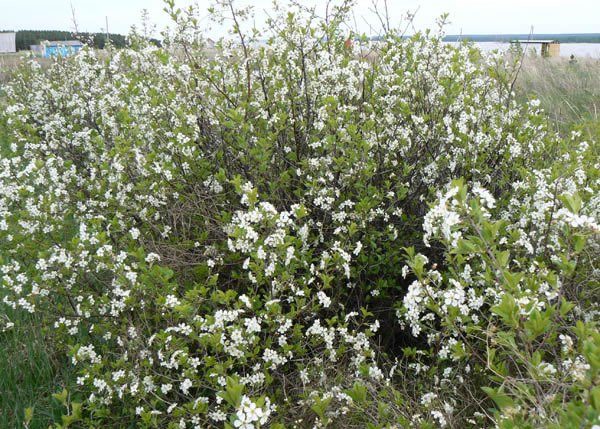
The duration of flowering is average, quite stretched in time. Blossoming is usually observed on May 20-31. During this period, flowers appear on the trees, which have the following characteristics:
- The flowers have a small size, they are located on a short pedicle;
- In one inflorescence may be about 5-6 flowers;
- All petals are spacious, at a decent distance from each other;
- The form of petals is oval with a wide forked upper part;
- The top of the cup is widened with a bell-shaped form, has a weak serration;
- The corolla is designed as an oval-saucer-shaped;
- Stamens are located above the stigma of the pistil, their number can reach up to 26 pieces.
Yield
Steppe-type cherry has a stable yield level. Trees produce high yields every year.
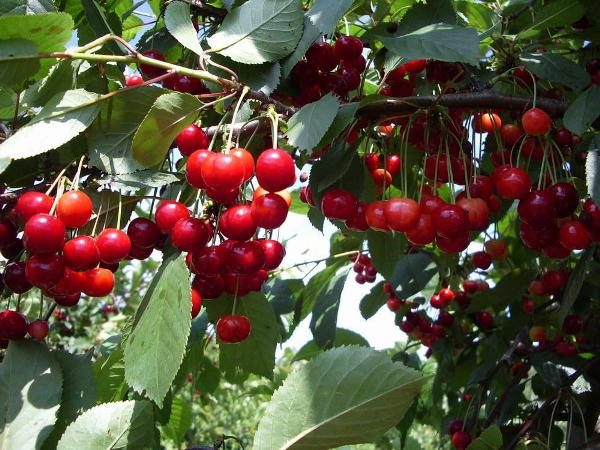
The fruits have late ripening. The full ripening of the berry occurs around the beginning of August.. Berries ripen at the same time. With increased precipitation, the berry can crack.
Full fruiting begins at 4-5 years of life after planting seedlings. One tree can bear fruit well for 35 years..
Frost resistance
Steppe-type cherry trees tolerate strong frosts. Plants can safely tolerate frosts down to -48 degrees Celsius.
In winter, fruit-bearing buds can withstand medium frosts, almost as much as trees to -45-48 degrees Celsius. Inflorescences and buds have frost resistance slightly above average.
Advantages and disadvantages of steppe cherries
The advantages of steppe cherry are the following qualities:
- High yield. From one tree you can collect almost 12 kilograms of ripe berries;
- Drought tolerance and frosts;
- Annual fruiting;
- Long life trees, almost 35 years;
- Big berry the same size;
- High resistance to diseases;
- Breeding can occur in various ways;
- Ripe fruit possess excellent taste. In addition, they have a high level of useful components that are useful for the full operation of the digestive system, as well as they improve the condition of human blood formation;
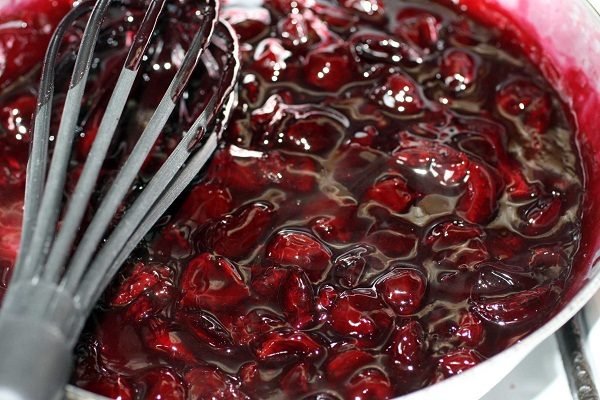
- Ripe berry can be used for cooking. juices, jams, jams, compotes, jam and other winter preparations.
However, there are negative qualities:
- Late ripeningat the beginning of the last month of summer;

- Fruiting occurs only in 2-4 years after planting seedlings;
- The soft structure of ripe fruit often damaged by precipitation and transport.
Features of planting and care
For a start, it is worth highlighting the main methods of breeding steppe cherries:
- With the help of cuttings;
- Due to shoots;
- Bones;
- With the help of vaccinations.
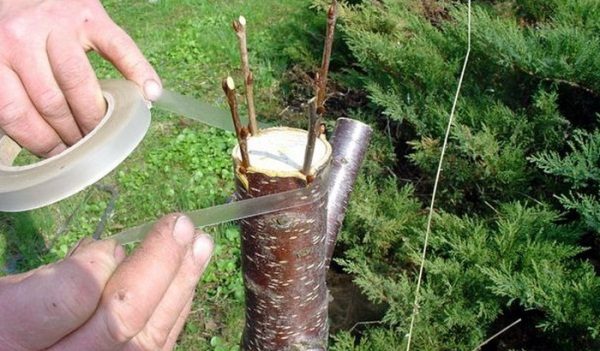
In early June, you need to prepare shoots. It is important that they are with a reddish tinge, with a slight hardening at the base.
The length of the prepared shoots should be more than 30 cm. Circumcision should be done in the evening or early in the morning. The weather should be cool. After the stems are cut, they need to be placed in water. In order to speed up the process of the root system, it is desirable to use special chemical growth regulators.
Heteroauxin may be used as a growth regulator.. 100 ml of this product is diluted with water and ethyl alcohol. Then you need to tie the cuttings and lower in 1 liter of this solution. Keep in this mixture, the cuttings should be within 18 hours.
The landing process has certain nuances that should be strictly followed:
- Follows in advance dig the soil, remove all weeds and unwanted plants, form beds;
- All notches should fill with peat and sandThe size of the layer should be about 10 cm;
- Further river sand is poured from aboveall loosened, leveled and tamped;
- Thereafter the land is abundantly watered and fed with superphosphate;
- Cuttings should be planted in an upright position., the distance between the trees should be at least 7 cm;
- Should be planted no more than 3 cm deep;
- After that all seedlings are covered with a plastic bag;
- In the next period is ensure good watering.
Watering and fertilizer - the key to a good harvest
During intensive growth, appropriate watering should be ensured. It is carried out 2-3 times. For each watering for one tree will take about 3-5 buckets. The first watering is done immediately after flowering, additional fertilizing is added, the second is done immediately after the fruit ovary, the third during the ripening of the berries. Before flowering organic and mineral fertilizers are applied, then they are introduced after flowering and at the moment of fruit ovary.
Varieties of varieties: Ashinsky, Bolotovskaya and others
So that the choice does not cause difficulties, it is worth knowing which varieties belong to the steppe cherry. Below we consider the most popular varieties:
- Generous. It has a high yield, up to 11 kilograms can be removed from one tree. The flowering period from May 18-25. Fruiting occurs with 3-4 years of life after disembarkation. It has high drought resistance and frost resistance. Life expectancy is 32 years;
- Bolotovskaya. High-yielding late variety. Fruiting begins with 2-3 years of life after disembarkation. Life span up to 30 years;
- Ashinskaya. High-yielding late variety. Fruiting begins in early August. Fruiting begins with 4-5 years of life after disembarkation. The term of life is 30-32 years;
- Maksimovskaya. Late fruiting high-yielding variety. Ripening begins in early August. Young trees begin to bear fruit only 3-4 years after they are planted. The average lifespan of trees is about 30-35 years.
- Steppe Ashinsky Cherry
- Cherry steppe Bolotovskaya
- Steppe cherry Maximovskaya
- Cherry Steppe Generous
Diseases and pests
Varieties of steppe type have an increased resistance to the effects of various diseases and pests. Trees are practically not susceptible to fungal types of disease - coccomycosis. As well as other types of fungal infections in steppe type cherries were not observed.
Steppe cherry has good qualities for which many gardeners and gardeners appreciate it. It has good yield, is resistant to frost and is practically not susceptible to diseases.. And her crops always delight every year and in large quantities. But still, in order to obtain the desired result, the varieties of this plant must be cared for - water, fertilize, carry out the autumn and spring digging of the ground near the trunk. This is the only way to grow a cherry, the crops of which will delight every year.

